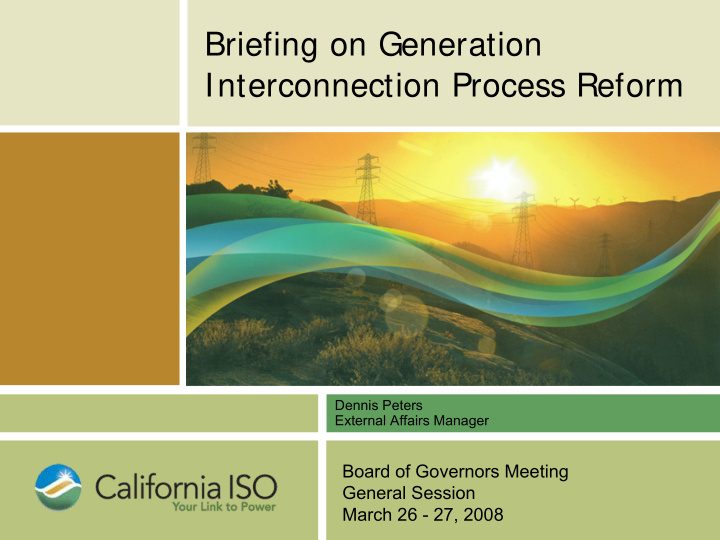



Briefing on Generation Interconnection Process Reform Dennis Peters External Affairs Manager Board of Governors Meeting General Session March 26 - 27, 2008
The current process is based on FERC Order 2003. Key Objectives of Order 2003 � Maintain FERC Order 888’s requirement of nondiscriminatory and open access transmission service � Facilitate market entry for new generation by reducing interconnection costs and time Some underlying assumptions are no longer valid � Process assumed unused transmission capacity � Process designed around single large thermal plants close to load 2
Active projects in the queue today exceed the CAISO all- time system peak of 50,270 MW. 188 interconnection requests active today � Total 62,608 MW � 131 renewable projects total 42,526 MW Interconnection requests for renewable projects are growing year to year: � January 2006 5,700 MW Renewable generation is typically located in areas with inadequate � January 2007 11,000 MW transmission infrastructure. � January 2008 42,526 MW 3
The current process is inefficient. Serial study approach → problematic � Incremental planning → disproportionate cost allocation � Withdrawals → restudies. Ease of entry and lack of viability measures → queue management complication 4
CAISO’s process reform was accelerated when FERC… Acknowledged challenges with current process Held nationwide technical conference last December Requested CAISO to file reform proposal by Spring 2008 CAISO initiated the Generation Interconnection Process Reform in January. 5
CAISO is working with stakeholders to achieve the following process reform goals. Clear existing queue backlog Make process more efficient Provide cost and timing certainty Integrate better with CAISO Transmission Planning Process (TPP) Allow integration of state efforts to identify transmission needs for Energy Resource Areas 6
The reform proposal seeks to resolve flaws in an innovative manner. Problem Solution Inefficient serial study Study projects in groups approach Allocate network upgrades prorata Feed projects with Interconnection Agreements (IAs) into CAISO TPP Non-viable projects Increase financial commitments and consequences for delay or withdrawal Accelerate site control requirement Require binding financial commitment for signing IAs 7
The reform proposal also addresses the existing queue backlog. Divides existing applications into two groups based upon original System Impact Study due date � Study due before 2/1/08 – studied serially under existing rules � Study due after 2/1/08 – studied in a group under reform proposal rules Requires greater financial commitment from both groups 8
Stakeholder Process Schedule January 18 CAISO posted Issues Identification Paper January 25 First Stakeholder Meeting February 4 Stakeholder comments received February 12 Draft Proposal February 19 Second Stakeholder Meeting February 26 Stakeholder comments received 2 nd Draft Proposal March 12 March Weekly Stakeholder Conference Calls March 26 ISO Governing Board (Briefing) April 18 CAISO to post Final Proposal & Draft Tariff language April 21 Status report due to FERC April 25 Stakeholder Meeting May 21-22 ISO Governing Board (Decision) Early June FERC Filing 9
Recommend
More recommend